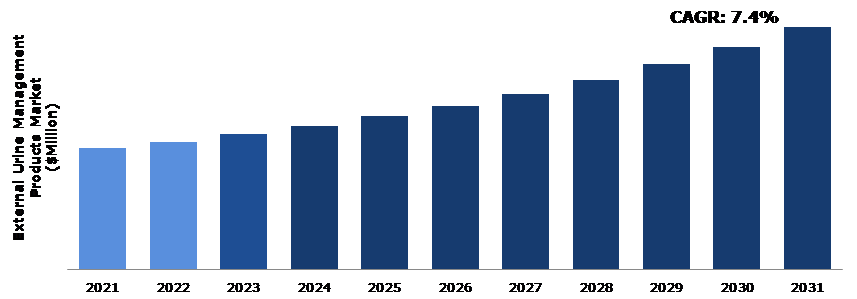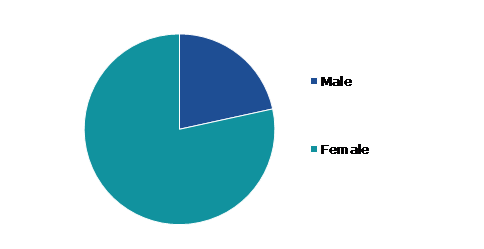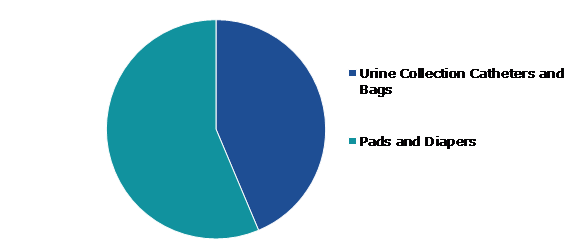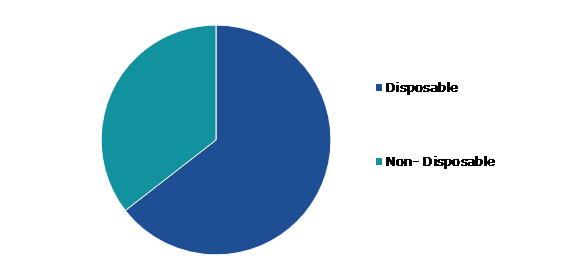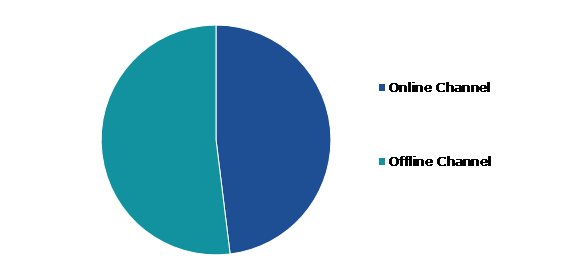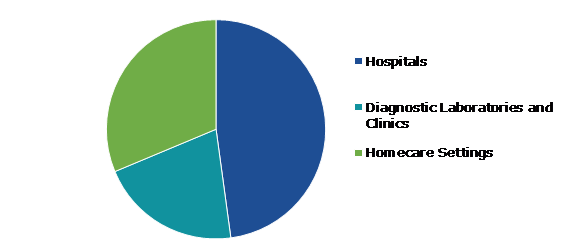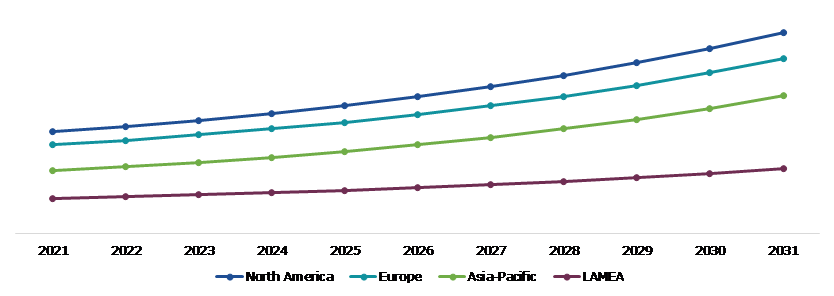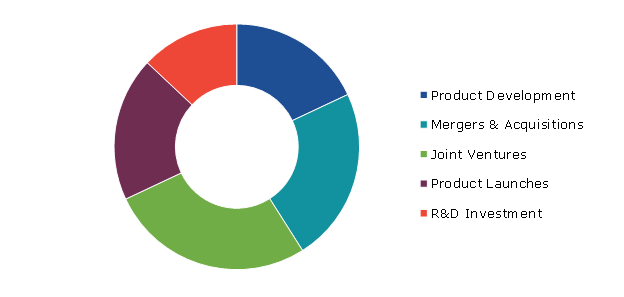External Urine Management Products Market Report
RA08593
External Urine Management Products Market, by Gender (Male and Female), Product Type (Urine Collection Catheters & Bags and Pads & Diapers), Product Category (Disposable and Non-Disposable), Distribution Channel (Online Channel and Offline Channel), and End User (Hospitals, Diagnostic Laboratories & Clinics, and Homecare Settings): Global Opportunity Analysis and Industry Forecast 2022–2031
Global External Urine Management Products Market Analysis
The global external urine management products market size was $15,940million in 2021 and is predicted to expand at a CAGR of 7.4%, generating a revenue of $31,929.3 million by 2031.
Global External Urine Management Products Market Synopsis
A product or catheter that attaches to the perineum is referred to as an external urine management product (EUMP). EUMPs are primarily used to collect urine in both men and women who have urinary incontinence (UI). The catheterization strategy is determined by the underlying bladder issue, treatment goals, and gender appropriateness. External urinary catheters are necessary for collecting urine in patients. UI is a common medical issue. All these factors are expected to drive the market expansion and demand during the forecast period.
Catheterization is a challenging technique because inadequately lubricated catheters may cause friction between the urethral walls and the device's edge, which is not only painful for the patient but may also lead to urethral narrowing, bleeding, and infection with sustained use. Such factors are projected to impede the external urine management products market growth during the forecast period.
External catheters are mostly used to treat urinary incontinence (UI) and urinary retention (UR). Urinary incontinence is the involuntary loss of urine caused by either stress incontinence (urine leakage with activities such as laughing, overflowing, or coughing) or urgency incontinence (urine leakage without activities such as coughing or overflowing). Furthermore, loss of urine due to urgency and the frequency of overactive bladder disorders are likely to fuel the demand for the external urine management products market growth during the forecast period.
According to regional analysis, the North America external urine management products market accounted for the highest market share in 2021.The use of external urine management products in North America is under large-scale development as the number of urinary problems is increasing rapidly in the region.
External Urine Management Products Overview
External urine management products are in high demand due increase in urinary diseases such as urinary incontinence, BPH, and others. Urinary catheters, pads, and diapers are used to manage urinary incontinence, which cannot be managed surgically or medically. Urinary incontinence is associated primarily with the aging population and obesity, which are anticipated to be more prevalent.
COVID-19 Impact on Global External Urine Management Products Market
The COVID-19 pandemic brought several uncertainties, leading to severe economic losses as various businesses across the world were on standstill. However, it positively impacted the healthcare industry. COVID-19 primarily affects the geriatric population and is more common in those with low or poor immunity. The rise in admission rates in hospitals increased the demand for external urine management products across several countries. A number of established pharmaceutical and biopharmaceutical businesses boosted R&D and production efforts to create innovative ways to tackle COVID-19 after the World Health Organization (WHO) declared the COVID-19 outbreak as a pandemic. Several pharmaceutical and biotechnology businesses collaborated with their outsourcing companies through long-term agreements, partnerships, and collaborations around the world during the pandemic to accelerate the R&D process.
For instance, in March 2020, the Ministry of Health and Family Welfare mandated the usage of advanced telemedicine and telehealth procedures throughout India during the initial lockdown. The government released official guidelines for telemedicine practices across the country in partnership with the Indian government’s NITI Aayog. These initiatives are predicted to drive the external urine management products market size during the forecast period.
Increase in Applications of External Urine Management Products in Hospitals to Drive Market Growth
The increase in the prevalence of urine incontinence in the global female population is one of the important drivers for the external urine management products market. Annually, over 300 million surgical procedures are performed worldwide, with 40-50 million in the U.S. and about 20 million in Europe. The increase in the number of surgical procedures can significantly increase the need for external urine management products, which are commonly used in surgical patients to prevent urinary incontinence or urine retention in unconscious patients. Furthermore, according to data provided by the National Association for Incontinence, one in every four women experiences involuntary urine leakage. According to the World Health Organization (WHO), the prevalence of urinary incontinence was found to affect 14% of women population worldwide in 2021, which is projected to boost the global market during the forecast period.
To know more about global external urine management products market drivers, get in touch with our analysts here.
Lack of Awareness and Post-operative Complications Restrain Market Growth
External urine management products such as catheterization necessitate extra caution to avoid urinary tract infections (UTIs) or catheter-associated urinary tract infections (CAUTIs).Urinary tract infections caused by external urine management products are a serious concern in both hospital care and general practice. The infection burden is considerable, and there are numerous obstacles in diagnosis and management. Better education on asymptomatic bacteriuria and UTI presentation in the older population is needed, according to a number of studies. In elderly populations with significant degrees of cognitive impairment and communication challenges, such as institutional care residents, symptomatic infections are frequently difficult to detect. Different non-invasive and invasive therapy methods for transient incontinence and lack of awareness about recent advances in urinary incontinence devices as well as post-operative complications related to the products are anticipated to hamper the external urine management products market growth.
Use of External Urine Management Products for Prostate Cancer to Drive Excellent Opportunities
Rise n prevalence of prostate cancer may change the prognosis for external urine management solutions. Prostate cancer affects one in every nine males at some point in their lives. Prostate cancer is the second most frequent cancer in men, trailing only skin cancer. This form of cancer causes symptoms such as erectile dysfunction and difficulty in urinating. The person suffering from prostate cancer may require an external urine management product to aid in the healing of bladder or urethra or to reduce the side effects of treatment. It is highly usual for patients with prostate cancer to require a urinary catheter at some point during or after their treatment. External urine management product demand is increasing as a result of the rise in prostate cancer incidence, which emphasizes the importance of early diagnosis and treatment. Patients' preference for self-catheterization, an increase in the number of ambulatory surgery centers, and favorable medical reimbursement legislation are estimated to provide numerous growth opportunities in the market during the forecast period.
To know more about global external urine management products market opportunities, get in touch with our analysts here.
Global External Urine Management Products Market, by Gender
On the basis of gender, the market is classified into male and female. Among these, the female segment accounted for the highest market share in 2021 and is estimated to witness the fastest growth during the forecast period.
Global External Urine Management Products Market Growth, by Gender, 2021
Source: Research Dive Analysis
The female segment accounted for a dominating market share in 2021. Several females wear protective pads, shields, or diapers to prevent their garments against urinary leaks. Alternatively, specifically designed absorbent female external urine products can be worn simply under normal clothing. In elderly females, urine retention is more common during hospitalization associated with ambulatory ability, physical function, and mortality. Those who have anatomical outlet obstruction or bladder malfunction are more likely to have urinary incontinence, which is more prevalent in women. By contrast, those who have neurological disease or infection, take medication, and suffer from pain are more likely to have urine incontinence. These aspects are predicted to drive the growth of the female segment in the external urine management market share.
Global External Urine Management Products Market, by Product Type
On the basis of product type, the market is divided into urine collection catheters & bags and pads& diapers. Among these, the pads & diapers segment accounted for the highest market share in 2021.
Global External Urine Management Products Market Analysis, by Product Type, 2021
Source: Research Dive Analysis
The pads & diapers segment accounted for a dominating market share in 2021. There is hydrophobic layer in pads and diapers that keeps the body liquid away from the products’ surface, preventing skin from becoming wet. Pads and diapers may be required for individuals suffering from disorders such as incontinence, mobility limitation, severe diarrhea, or dementia. Pads and diapers come in a variety of styles, including those that look like underpants. Pads that look like sanitary napkins are also known as incontinence pads. They are safe and hygienic and provide excellent incontinence management. Pads and diapers can be discarded in the garbage and replaced with a new one. These factors are anticipated to drive the growth of the pads & diapers segment in the external urine management products market size.
Global External Urine Management Products Market, by Product Category
On the basis of product category, the market is classified into disposable and non-disposable. Among these, the disposable segment accounted for the highest market share in 2021.
Global External Urine Management Products Market Outlook, by Product Category, 2021
Source: Research Dive Analysis
The disposable sub-segment accounted for a dominating market share in 2021. The growth in demand for disposables is due to an increase in personal hygiene product consumption, the rise in prevalence of chronic renal disease and bladder infection, an aging population, and neurological traumas. In developed countries, the increasing availability and usage of disposable incontinence products in home care settings is predicted to drive the segment growth. The increase in the frequency of chronic disorders, such as prostatic hyperplasia and end-stage renal disease, is anticipated to boost the disposable product category segment of the external urine management products market revenue.
Global External Urine Management Products Market, by Distribution Channel
On the basis of distribution channel, the market is divided into online channel and offline channel. Among these, the offline channel segment accounted for the highest market share in 2021.
Global External Urine Management Products Market Forecast, by Distribution Channel, 2021
Source: Research Dive Analysis
The offline segment accounted for a dominating market share in 2021. The offline category has a dominant market share due to its widespread availability around the world. The bulk of consumers still prefer shopping through the offline distribution channel since it provides product verification, authenticity, and certainty. Offline retailers provide consumers with convenience, personalization, and personal help, which is expected to fuel industry expansion.
Global External Urine Management Products Market, by End User
On the basis of end user, the market is divided into hospitals, diagnostic laboratories & clinics, and homecare settings. Among these, the hospital segment accounted for the highest market share in 2021.
Global External Urine Management Products Market Revenue, by End User,2021
Source: Research Dive Analysis
The hospitals segment accounted for a dominating market share in 2021. The type of external urinary management product utilized is determined by the underlying bladder condition and gender appropriateness. The rise in frequency of end-stage renal disease and the increase in the number of surgical procedures being performed are the two key factors driving the segment growth. Older people need hospital visits more than younger patients and are more prone to urinary disease. More of them attend the emergency department, stay in the hospital for longer duration, and require external urine management products during their hospital stay. These factors are anticipated to boost the external urine management products market share in the hospital segment.
Global External Urine Management Products Market, Regional Insights
The external urine management products market was investigated across North America, Europe, Asia-Pacific, and LAMEA.
Global External Urine Management Products Market Size & Forecast, by Region, 2021-2031 ($ Million)
Source: Research Dive Analysis
Market for External Urine Management Products in North America to be the Most Dominant
The North America external urine management products market accounted for a dominating market share in 2021. The demand for external urine management products in the region is driven by the rising occurrence of particular ailments such as bladder obstruction, urinary tract infection (UI), urine retention, and bladder cancer. According to the American Academy of Family Physicians, around 250,000 people with benign prostate hyperplasia receive surgery each year. This disorder can be caused by aging or injuries to the penis, urethra, or bladder, and it is also linked to pregnancy. The growing geriatric population, together with rising life expectancy, has resulted in an increase in the number of patients receiving procedures, fueling the external urine management products market share in North America region.
Competitive Scenario in the Global External Urine Management Products Market
Product launches and mergers & acquisitions are common strategies followed by the major market players. For instance, in June 2022, Hollister Incorporated, a global medical device company, entered into a three-year group purchasing agreement with Vizient, Inc., the biggest member-driven healthcare performance improvement company in the U.S., for urological goods. This new agreement provides Vizient members with improved access to the whole portfolio of Hollister Incorporated urological devices, including its VaProTM hydrophilic catheters.
Source: Research Dive Analysis
Some of the leading external urine management products market players include Teleflex, Inc., Tilla Care, Inc., Consure Medical, Men’s Liberty (BioDerm), Boehringer Laboratories, LLC, Hollister, Inc., Coloplast Corp., Sterimed Group, B. Braun Melsungen AG, and Cardinal Health.
| Aspect | Particulars |
| Historical Market Estimations | 2020 |
| Base Year for Market Estimation | 2021 |
| Forecast Timeline for Market Projection | 2022-2031 |
| Geographical Scope | North America, Europe, Asia-Pacific, and LAMEA |
| Segmentation by Gender
|
|
| Segmentation by Product Type
|
|
| Segmentation by Product Category
|
|
| Segmentation by Distribution Channel
|
|
| Segmentation by End User
|
|
| Key Companies Profiled |
|
Q1. What is the size of the global external urine management products market?
A. The size of the global external urine management products market was over $15,940 million in 2021 and is projected to reach $31,929.3 million by 2031.
Q2. Which are the major companies in the external urine management products market?
A. Teleflex, Inc., Tilla Care, Inc., and Consure Medical are some of the key players in the global external urine management products market.
Q3. Which region, among others, possesses greater investment opportunities in the near future?
A. Asia-Pacific possesses great investment opportunities for investors in the future.
Q4. What will be the growth rate of the Asia-Pacific external urine management products market?
A. Asia-Pacific external urine management products market is anticipated to expand at 4.9% CAGR during the forecast period.
Q5. What are the strategies opted by the leading players in the market?
A. Product launches and mergers & acquisitions are the two key strategies opted by the companies operating in the market.
Q6. Which companies are investing more in R&D practices?
A. Sage Products LLC (Stryker Corporation) and Hollister, Inc. are the companies investing more in R&D activities to develop new products and technologies.
1.Research Methodology
1.1.Desk Research
1.2.Real time insights and validation
1.3.Forecast model
1.4.Assumptions and forecast parameters
1.5.Market size estimation
1.5.1.Top-down approach
1.5.2.Bottom-up approach
2.Report Scope
2.1.Market definition
2.2.Key objectives of the study
2.3.Report overview
2.4.Market segmentation
2.5.Overview of the impact of COVID-19 on Global external urine management products market
3.Executive Summary
4.Market Overview
4.1.Introduction
4.2.Growth impact forces
4.2.1.Drivers
4.2.2.Restraints
4.2.3.Opportunities
4.3.Market value chain analysis
4.3.1.List of raw material suppliers
4.3.2.List of manufacturers
4.3.3.List of distributors
4.4.Innovation & sustainability matrices
4.4.1.Technology matrix
4.4.2.Regulatory matrix
4.5.Porter’s five forces analysis
4.5.1.Bargaining power of suppliers
4.5.2.Bargaining power of consumers
4.5.3.Threat of substitutes
4.5.4.Threat of new entrants
4.5.5.Competitive rivalry intensity
4.6.PESTLE analysis
4.6.1.Political
4.6.2.Economical
4.6.3.Social
4.6.4.Technological
4.6.5.Legal
4.6.6.Environmental
4.7.Impact of COVID-19 on external urine management products market
4.7.1.Pre-covid market scenario
4.7.2.Post-covid market scenario
5.External Urine Management Products Market Analysis, by Gender
5.1.Overview
5.2.Male
5.2.1.Definition, key trends, growth factors, and opportunities
5.2.2.Market size analysis, by region, 2021-2031
5.2.3.Market share analysis, by country, 2021-2031
5.3.Female
5.3.1.Definition, key trends, growth factors, and opportunities
5.3.2.Market size analysis, by region, 2021-2031
5.3.3.Market share analysis, by country, 2021-2031
5.4.Research Dive Exclusive Insights
5.4.1.Market attractiveness
5.4.2.Competition heatmap
6.External Urine Management Products Market Analysis, by Product Type
6.1.Overview
6.2.Urine Collection Catheters and Bags
6.2.1.Definition, key trends, growth factors, and opportunities
6.2.2.Market size analysis, by region, 2021-2031
6.2.3.Market share analysis, by country, 2021-2031
6.3.Pads and Diapers
6.3.1.Definition, key trends, growth factors, and opportunities
6.3.2.Market size analysis, by region, 2021-2031
6.3.3.Market share analysis, by country, 2021-2031
6.4.Research Dive Exclusive Insights
6.4.1.Market attractiveness
6.4.2.Competition heatmap
7.External Urine Management Products Market Analysis, by Product Category
7.1.Overview
7.2.Disposable
7.2.1.Definition, key trends, growth factors, and opportunities
7.2.2.Market size analysis, by region, 2021-2031
7.2.3.Market share analysis, by country, 2021-2031
7.3.Non- Disposable
7.3.1.Definition, key trends, growth factors, and opportunities
7.3.2.Market size analysis, by region, 2021-2031
7.3.3.Market share analysis, by country, 2021-2031
7.4.Research Dive Exclusive Insights
7.4.1.Market attractiveness
7.4.2.Competition heatmap
8.External Urine Management Products Market Analysis, by Distribution Channel
8.1.Overview
8.2.Online Channel
8.2.1.Definition, key trends, growth factors, and opportunities
8.2.2.Market size analysis, by region, 2021-2031
8.2.3.Market share analysis, by country, 2021-2031
8.3.Offline channel
8.3.1.Definition, key trends, growth factors, and opportunities
8.3.2.Market size analysis, by region, 2021-2031
8.3.3.Market share analysis, by country, 2021-2031
8.4.Research Dive Exclusive Insights
8.4.1.Market attractiveness
8.4.2.Competition heatmap
9.External Urine Management Products Market Analysis, by End User
9.1.Overview
9.2.Hospitals
9.2.1.Definition, key trends, growth factors, and opportunities
9.2.2.Market size analysis, by region, 2021-2031
9.2.3.Market share analysis, by country, 2021-2031
9.3.Diagnostic Laboratories and Clinics
9.3.1.Definition, key trends, growth factors, and opportunities
9.3.2.Market size analysis, by region, 2021-2031
9.3.3.Market share analysis, by country, 2021-2031
9.4.Homecare Settings
9.4.1.Definition, key trends, growth factors, and opportunities
9.4.2.Market size analysis, by region, 2021-2031
9.4.3.Market share analysis, by country, 2021-2031
9.5.Research Dive Exclusive Insights
9.5.1.Market attractiveness
9.5.2.Competition heatmap
10.External Urine Management Products Market, by Region
10.1.North America
10.1.1.U.S.
10.1.1.1.Market size analysis, by Gender, 2021-2031
10.1.1.2.Market size analysis, by Product Type, 2021-2031
10.1.1.3.Market size analysis, by Product Category,2021-2031
10.1.1.4.Market size analysis, by Distribution channel,2021-2031
10.1.1.5.Market size analysis, by End User
10.1.2.Canada
10.1.2.1.Market size analysis, by Gender,2021-2031
10.1.2.2.Market size analysis, by Product Type,2021-2031
10.1.2.3.Market size analysis, by Product Category,2021-2031
10.1.2.4.Market size analysis, by Distribution channel,2021-2031
10.1.2.5.Market size analysis, by End User,2021-2031
10.1.3.Mexico
10.1.3.1.Market size analysis, by Gender,2021-2031
10.1.3.2.Market size analysis, by Product Type,2021-2031
10.1.3.3.Market size analysis, by Product Category,2021-2031
10.1.3.4.Market size analysis, by Distribution channel,2021-2031
10.1.3.5.Market size analysis, by End User,2021-2031
10.1.4.Research Dive Exclusive Insights
10.1.4.1.Market attractiveness
10.1.4.2.Competition heatmap
10.2.Europe
10.2.1.Germany
10.2.1.1.Market size analysis, by Gender,2021-2031
10.2.1.2.Market size analysis, by Product Type,2021-2031
10.2.1.3.Market size analysis, by Product Category,2021-2031
10.2.1.4.Market size analysis, by Distribution channel,2021-2031
10.2.1.5.Market size analysis, by End User,2021-2031
10.2.2.UK
10.2.2.1.Market size analysis, by Gender,2021-2031
10.2.2.2.Market size analysis, by Product Type,2021-2031
10.2.2.3.Market size analysis, by Product Category,2021-2031
10.2.2.4.Market size analysis, by Distribution channel,2021-2031
10.2.2.5.Market size analysis, by End User,2021-2031
10.2.3.France
10.2.3.1.Market size analysis, by Gender,2021-2031
10.2.3.2.Market size analysis, by Product Type,2021-2031
10.2.3.3.Market size analysis, by Product Category,2021-2031
10.2.3.4.Market size analysis, by Distribution channel,2021-2031
10.2.3.5.Market size analysis, by End User,2021-2031
10.2.4.Spain
10.2.4.1.Market size analysis, by Gender,2021-2031
10.2.4.2.Market size analysis, by Product Type,2021-2031
10.2.4.3.Market size analysis, by Product Category,2021-2031
10.2.4.4.Market size analysis, by Distribution channel,2021-2031
10.2.4.5.Market size analysis, by End User,2021-2031
10.2.5.Italy
10.2.5.1.Market size analysis, by Gender,2021-2031
10.2.5.2.Market size analysis, by Product Type,2021-2031
10.2.5.3.Market size analysis, by Product Category,2021-2031
10.2.5.4.Market size analysis, by Distribution channel,2021-2031
10.2.5.5.Market size analysis, by End User,2021-2031
10.2.6.Rest of Europe
10.2.6.1.Market size analysis, by Gender,2021-2031
10.2.6.2.Market size analysis, by Product Type,2021-2031
10.2.6.3.Market size analysis, by Product Category,2021-2031
10.2.6.4.Market size analysis, by Distribution channel,2021-2031
10.2.6.5.Market size analysis, by End User,2021-2031
10.2.7.Research Dive Exclusive Insights
10.2.7.1.Market attractiveness
10.2.7.2.Competition heatmap
10.3.Asia Pacific
10.3.1.China
10.3.1.1.Market size analysis, by Gender,2021-2031
10.3.1.2.Market size analysis, by Product Type,2021-2031
10.3.1.3.Market size analysis, by Product Category,2021-2031
10.3.1.4.Market size analysis, by Distribution channel,2021-2031
10.3.1.5.Market size analysis, by End User,2021-2031
10.3.2.Japan
10.3.2.1.Market size analysis, by Gender,2021-2031
10.3.2.2.Market size analysis, by Product Type,2021-2031
10.3.2.3.Market size analysis, by Product Category,2021-2031
10.3.2.4.Market size analysis, by Distribution channel,2021-2031
10.3.2.5.Market size analysis, by End User,2021-2031
10.3.3.India
10.3.3.1.Market size analysis, by Gender,2021-2031
10.3.3.2.Market size analysis, by Product Type,2021-2031
10.3.3.3.Market size analysis, by Product Category,2021-2031
10.3.3.4.Market size analysis, by Distribution channel,2021-2031
10.3.3.5.Market size analysis, by End User,2021-2031
10.3.4.Australia
10.3.4.1.Market size analysis, by Gender,2021-2031
10.3.4.2.Market size analysis, by Product Type,2021-2031
10.3.4.3.Market size analysis, by Product Category,2021-2031
10.3.4.4.Market size analysis, by Distribution channel,2021-2031
10.3.4.5.Market size analysis, by End User,2021-2031
10.3.5.South Korea
10.3.5.1.Market size analysis, by Gender,2021-2031
10.3.5.2.Market size analysis, by Product Type,2021-2031
10.3.5.3.Market size analysis, by Product Category,2021-2031
10.3.5.4.Market size analysis, by Distribution channel,2021-2031
10.3.5.5.Market size analysis, by End User,2021-2031
10.3.6.Rest of Asia Pacific
10.3.6.1.Market size analysis, by Gender,2021-2031
10.3.6.2.Market size analysis, by Product Type,2021-2031
10.3.6.3.Market size analysis, by Product Category,2021-2031
10.3.6.4.Market size analysis, by Distribution channel,2021-2031
10.3.6.5.Market size analysis, by End User,2021-2031
10.3.7.Research Dive Exclusive Insights
10.3.7.1.Market attractiveness
10.3.7.2.Competition heatmap
10.4.LAMEA
10.4.1.Brazil
10.4.1.1.Market size analysis, by Gender,2021-2031
10.4.1.2.Market size analysis, by Product Type,2021-2031
10.4.1.3.Market size analysis, by Product Category,2021-2031
10.4.1.4.Market size analysis, by Distribution channel,2021-2031
10.4.1.5.Market size analysis, by End User,2021-2031
10.4.2.Saudi Arabia
10.4.2.1.Market size analysis, by Gender,2021-2031
10.4.2.2.Market size analysis, by Product Type,2021-2031
10.4.2.3.Market size analysis, by Product Category,2021-2031
10.4.2.4.Market size analysis, by Distribution channel,2021-2031
10.4.2.5.Market size analysis, by End User,2021-2031
10.4.3.UAE
10.4.3.1.Market size analysis, by Gender,2021-2031
10.4.3.2.Market size analysis, by Product Type,2021-2031
10.4.3.3.Market size analysis, by Product Category,2021-2031
10.4.3.4.Market size analysis, by Distribution channel,2021-2031
10.4.3.5.Market size analysis, by End User,2021-2031
10.4.4.South Africa
10.4.4.1.Market size analysis, by Gender,2021-2031
10.4.4.2.Market size analysis, by Product Type,2021-2031
10.4.4.3.Market size analysis, by Product Category,2021-2031
10.4.4.4.Market size analysis, by Distribution channel,2021-2031
10.4.4.5.Market size analysis, by End User,2021-2031
10.4.5.Rest of LAMEA
10.4.5.1.Market size analysis, by Gender,2021-2031
10.4.5.2.Market size analysis, by Product Type,2021-2031
10.4.5.3.Market size analysis, by Product Category,2021-2031
10.4.5.4.Market size analysis, by Distribution channel,2021-2031
10.4.5.5.Market size analysis, by End User,2021-2031
10.4.6.Research Dive Exclusive Insights
10.4.6.1.Market attractiveness
10.4.6.2.Competition heatmap
11.Competitive Landscape
11.1.Top winning strategies, 2021
11.1.1.By strategy
11.1.2.By year
11.2.Strategic overview
11.3.Market share analysis, 2021
12.Company Profiles
12.1.Teleflex Inc.
12.1.1.Overview
12.1.2.Business segments
12.1.3.Product portfolio
12.1.4.Financial performance
12.1.5.Recent developments
12.1.6.SWOT analysis
12.1.7.Research dive analyst view
12.2.Tilla Care Inc.
12.2.1.Overview
12.2.2.Business segments
12.2.3.Product portfolio
12.2.4.Financial performance
12.2.5.Recent developments
12.2.6.SWOT analysis
12.2.7.Research dive analyst view
12.3.Consure Medical
12.3.1.Overview
12.3.2.Business segments
12.3.3.Product portfolio
12.3.4.Financial performance
12.3.5.Recent developments
12.3.6.SWOT analysis
12.3.7.Research dive analyst view
12.4.Sage Products LLC (Stryker Corporation)
12.4.1.Overview
12.4.2.Business segments
12.4.3.Product portfolio
12.4.4.Financial performance
12.4.5.Recent developments
12.4.6.SWOT analysis
12.4.7.Research dive analyst view
12.5.Men’s Liberty (BioDerm)
12.5.1.Overview
12.5.2.Business segments
12.5.3.Product portfolio
12.5.4.Financial performance
12.5.5.Recent developments
12.5.6.SWOT analysis
12.5.7.Research dive analyst view
12.6.Boehringer Laboratories, LLC,
12.6.1.Overview
12.6.2.Business segments
12.6.3.Product portfolio
12.6.4.Financial performance
12.6.5.Recent developments
12.6.6.SWOT analysis
12.6.7.Research dive analyst view
12.7.Coloplast Corp.
12.7.1.Overview
12.7.2.Business segments
12.7.3.Product portfolio
12.7.4.Financial performance
12.7.5.Recent developments
12.7.6.SWOT analysis
12.7.7.Research dive analyst view
12.8.Sterimed Group
12.8.1.Overview
12.8.2.Business segments
12.8.3.Product portfolio
12.8.4.Financial performance
12.8.5.Recent developments
12.8.6.SWOT analysis
12.8.7.Research dive analyst view
12.9.Cardinal Health
12.9.1.Overview
12.9.2.Business segments
12.9.3.Product portfolio
12.9.4.Financial performance
12.9.5.Recent developments
12.9.6.SWOT analysis
12.9.7.Research dive analyst view
12.10.Hollister Inc.
12.10.1.Overview
12.10.2.Business segments
12.10.3.Product portfolio
12.10.4.Financial performance
12.10.5.Recent developments
12.10.6.SWOT analysis
12.10.7.Research dive analyst view
13.Appendix
13.1.Parent & peer market analysis
13.2.Premium insights from industry experts
13.3.Related reports
Chronic incontinence is a significant clinical issue for the elderly and is a prevalent consequence of several neurological illnesses. Urinary incontinence may be the deciding factor in a patient's need for long-term institutional care. Catheter associated urinary tract infections (CAUTIs) are prevalent hospital-acquired infections that continue to pose a considerable medical and financial burden on the healthcare system.
External urinary catheters (EUC) are collection devices or systems (referred to as external urine collection devices [EUCD] in the UroToday reference centre) for collecting and containing urine away from the perineum or penis into a drainage suction or bag via tubing into a container. A EUCD cannot be implanted in the kidney like a nephrostomy tube or stent, or in the bladder or urethra like a catheter for intermittent drainage or an indwelling (Foley) device. It is used to drain urine in those who have urinary incontinence and is attached to the genitalia or pubic area. As the device is connected to the body, they are often referred to as “bodyworn products.” The growth in the occurrence of urine incontinence in the global female population is one of the key factors boosting the growth of the external urine management products market.
Newest Insights in the External Urine Management Products Market
Numerous people with illnesses like bladder dysfunction, such as cystitis, urinary incontinence, UI, benign prostatic hyperplasia, and kidney stones have benefited from recent advancements in the field of external urine management products. As per a report by Research Dive, the global external urine management products market is expected to surpass a revenue of $31,929.3 million in the 2022-2031 timeframe. The North America external urine management products market is expected to perceive dominant growth in the years to come. This is because the region has a gigantic demand for external urine management products owing to the increasing geriatric population, rising occurrence of disorders like urinary tract infection (UI), bladder obstruction, urine retention, and bladder cancer growth, and growing life expectancy in the region.
How are Market Players Responding to the Rising Demand for External Urine Management Products?
Market players are greatly investing in pioneering research and inventions to cater for the rising demand for external urine management products. Some of the foremost players in the external urine management products market are Tilla Care, Inc., Teleflex, Inc., Men’s Liberty (BioDerm), Consure Medical, LLC, Boehringer Laboratories, Coloplast Corp., Hollister, Inc., B. Braun Melsungen AG, Sterimed Group, Cardinal Health, and others. These players are focused on planning and devising tactics such as mergers and acquisitions, collaborations, novel advances, and partnerships to reach a notable position in the global market.
For instance,
- In January 2022, Stryker, a large international firm that manufactures medical technologies, in collaboration with clinicians, launched Sage PrimaFit® external urine management for the female anatomy to assist patients to receive better care.
- In September 2022, Sysmex, a suite of urinalysis, hematology, flow cytometry analyzers, and hemostasis for acute and non-acute healthcare settings, introduced a novel product for the field of urine sediment testing, the UF-1500 Fully Automated Urine Particle Analyzer.
- In November 2022, Ur24Technology, an external catheter system developed to enhance men's and women's quality of comfort, life, and self-esteem, launched the innovative "TrueClr" external catheter line.
COVID-19 Impact on the Global External Urine Management Products Market
The unpredicted rise of the coronavirus pandemic in 2020 has positively impacted the global external urine management products market. The COVID-19 virus primarily affects the elderly population and is more prevalent in persons with low or inadequate immunity. The need for external urine management solutions surged across several nations as hospital admission rates increased rapidly. After the World Health Organization (WHO) declared the COVID-19 outbreak as a pandemic, several well-established biopharmaceutical and pharmaceutical companies increased production and R&D efforts to create innovative ways to combat COVID-19. During the pandemic, several pharmaceutical and biotechnology corporations worked with their outsourcing businesses through partnerships, collaborations, and long-term agreements to speed up the R&D procedures. These measures are expected to propel the external urine management products market growth throughout the forecast period.
Personalize this research
- Triangulate with your own data
- Request your format and definition
- Get a deeper dive on a specific application, geography, customer or competitor
- + 1-888-961-4454 Toll - Free
- support@researchdive.com

